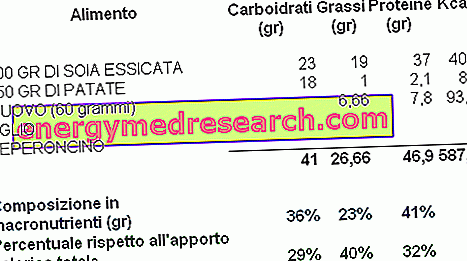Generality
The ulnar nerve is an important peripheral nerve of the upper limb, which originates from the so-called brachial plexus, runs through the arm and the forearm, and finally reaches the hand.

Containing the nerve fibers of the spinal roots C8 and T1, the ulnar nerve covers both motor functions and sensitive functions; in fact, it controls some forearm and different muscles of the hand (motor functions), and provides for the sensitive cutaneous perception of the palmar and dorsal sides of the little finger and the ring finger of the hand (sensitive functions).
The ulnar nerve can be the object of injuries or compressions, which can affect its functioning more or less profoundly.
Short review of what a nerve is
To fully understand what a nerve is, it is necessary to start from the concept of neuron .
Neurons represent the functional units of the nervous system . Their task is to generate, exchange and transmit all those (nervous) signals that allow muscle movement, sensory perceptions, reflex responses and so on.
Typically, one neuron consists of three parts:
- The so-called body, where the cell nucleus resides.
- Dendrites, which are equivalent to receiving antennae for nerve signals from other neurons or receptors located in the periphery.
- Axons, which are cellular extensions having the function of spreading the nervous signal. The axon covered with myelin (myelin sheath) is also called nerve fiber.
A bundle of axons forms a nerve .
Nerves can carry information in three ways:
- From the central nervous system (CNS) to the periphery . The nerves with this property are called efferent. The efferent nerves control the movement of the muscles, so I am in charge of the motor sphere.
- From the periphery to the CNS . Nerves with this capacity are called afferent. The afferent nerves signal to the CNS what they detected in the periphery, therefore they cover a sensitive (or sensory) function.
- From the SNC to the periphery and vice versa . Nerves with this double capacity are called mixed. Mixed nerves have a dual function: motor and sensory.
What is the Ulnare Nerve?
The ulnar nerve is a peripheral nerve of the upper limbs, known to be one of the five terminal nerve branches of the so-called brachial plexus .
Equipped with both a sensory function and a motor function, the ulnar nerve owes its name to the fact that, during its journey along the upper limb, it flanks the ulna, or one of the two bones of the forearm (the other bone is the radio ).
The ulnar nerve is also known to be the largest unprotected nerve in the human body, where "unprotected" means that it lacks the protection of muscles or bony portions; this curious feature is the reason why, as will be seen in the chapter on pathologies, the ulnar nerve is particularly susceptible to injury from trauma.
In addition to the ulnar nerve, the other 4 terminal nerve branches of the brachial plexus are: the musculocutaneous nerve, the axillary nerve, the median nerve and the radial nerve.
What is the brachial plexus?
Before proceeding with the description of the ulnar nerve, it is necessary to take a small step back and briefly review, also through the use of a figure, what the brachial plexus is.
The brachial plexus is the important complex (or formation) of nerve structures that:
- It originates from the anterior branches of the last 4 cervical spinal nerves (C5, C6, C7 and C8) and of the first thoracic spinal nerve (T1);
- It provides both sensory innervation and motor innervation of a part of the chest, shoulder, arm, forearm and hand.
Normally, the anatomists divide the brachial plexus into 5 sections, which from the first (representing the origin of the brachial plexus) to the last (representing instead the conclusion of the brachial plexus) are: the section of the 5 roots, the section of the 3 trunks, the section of the 6 divisions, the section of the 3 strings and the section of the 5 terminal branches .
In such a context, the ulnar nerve is placed at the level of the last section of the brachial plexus; of facts, as previously stated, is one of the 5 terminal nerve branches of the brachial plexus.

Anatomy
The ulnar nerve is a continuation of the medial chord of the brachial plexus . The medial chord of the brachial plexus is the section of the latter, in which the nerve bundles of the spinal roots C8 and T1 converge; therefore, returning to the ulnar nerve, this groups together the same nerve bundles belonging to the newly named spinal roots.
Like the radial nerve and the median nerve, the ulnar nerve also gives rise, in its path along the arm, to the forearm and the hand, to various branches, which take the name of branches of the ulnar nerve (NB: be careful not to confuse the branches of the ulnar nerve with terminal nerve branches of the brachial plexus).
In the next sections, the article will talk about the point of origin and course of the ulnar nerve as well as each of its branches.
Origin and course of the ulnar nerve
As a terminal branch of the brachial plexus, the ulnar nerve begins approximately at the height of the armpit . In other words, the ulnar nerve takes shape, detaching itself from the brachial plexus, a few centimeters lower than the shoulder, on the inner side of the first portion of the arm.
From the axilla, therefore, the ulnar nerve descends along the arm in a postero-medial position with respect to the humerus (that is, between the back and the inside of the humerus), until it reaches, at the elbow level, the so-called cubital tunnel ( here, it passes immediately under the medial epicondyle of the humerus).
After passing through the cubital tunnel, the ulnar nerve begins its transit through the forearm. Here, it starts in the direction of the hand occupying an antero-medial position (ie between the front and the back of the forearm); during its journey along the forearm, the ulnar nerve closely supports the ulna, the so-called ulnar artery and the ulnar flexor carpus muscle .
Once through the forearm, the ulnar nerve enters the so-called ulnar canal (or Guyon canal ) and reaches the hand, to be precise the palm of the hand. During the passage inside the ulnar canal, the ulnar nerve passes above a particular fibrous band, located on the palmar side of the wrist and known as the transverse carpal ligament (or flexor retinaculum ).
Curiosity
The superior transit of the ulnar nerve with respect to the transverse carpal ligament contrasts with the lower one of the median nerve, ie the nerve famous for being the protagonist of carpal tunnel syndrome.
Branches of the ulnar nerve
During its journey, the ulnar nerve gives rise to two groups of branches (or branches).
A first grouping is along the forearm (branches of the ulnar nerve of the forearm) and includes:
- The muscular branches of the ulnar nerve;
- The palmar branch of the ulnar nerve;
- The dorsal branch of the ulnar nerve.
The second group is at the level of the hand (branches of the ulnar nerve of the hand) and includes:
- The superficial branch of the ulnar nerve;
- The deep branch of the ulnar nerve.
Function
Thanks to its branches, the ulnar nerve covers - as initially stated - both motor functions (ie it controls muscles) and sensitive functions (ie it deals with the perceptive cutaneous capacity of some specific areas of the upper limb).
Motor functions
The ulnar nerve controls some of the forearm and hand muscles through its muscular branches, its deep branch and its superficial branch.
Going into more detail,
- In the forearm, using the muscle branches, check:
- The flexor carpi ulnar muscle;
- The medial half of the deep flexor muscle of the fingers.
- In the hand, by means of the deep branch, check:
- 3 of the 4 muscles of the hypotenar eminence (abductor muscle of the little finger, flexor muscle of the little finger and opponent's muscle of the little finger);
- The lumbrical muscles III and IV;
- Dorsal interosseous muscles;
- The interosseous palmar muscles (or volatile interosseous muscles);
- The adductor muscle of the thumb (see eminence tenar);
- The short flexor muscle of the thumb.
- Always in the hand, by means of the superficial branch, check:
- The remaining muscle of the hypotenar eminence called the short palmar muscle.
Sensitive functions
The ulnar nerve innervates the palmar and dorsal skin of the fifth finger of the hand (little finger) and the palmar and dorsal skin of the medial half of the fourth finger of the hand (half of the ring finger closest to the little finger).
The palmar branch of the ulnar nerve, which originates in the forearm, deals with the palmar cutaneous innervation; the dorsal branch of the ulnar nerve, which also originates in the forearm, deals with dorsal cutaneous innervation instead.
As can be concluded from what has just been stated, the place of origin of the branches of the ulnar nerve is not always related to its site of action (the two branches mentioned above arise in the forearm, but act at the level of the hand).
diseases
The ulnar nerve can be a victim of injury or compression . Lesions and compressions of the ulnar nerve are injuries, which can affect more or less deeply both the motor function and the sensitive nerve function in question.
The precise consequences (ie the symptoms) of the injurious or compressive phenomena depend on the location of the latter, along the course of the ulnar nerve.
Below, the article will deal with the most common and medically interesting ulnar nerve lesion or compression sites, namely the elbow and the wrist .
Ulnar nerve injuries at the elbow
At the elbow, the ulnar nerve can be the subject of injury on the occasion of:
- Cubital tunnel syndrome . In this circumstance, the ulnar nerve is the victim of a compression phenomenon.
- Fracture of the medial epicondyle of the humerus . In this situation, the ulnar nerve undergoes a trauma that causes its injury; the extent of the injury depends on the severity of the trauma.
The motor repercussions of these two medical conditions are:
- Loss of bending capacity of the ring finger and / or little finger;
- Sense of weakness during wrist flexion;
- A deformity of the hand at rest, known as a claw hand ;
- Sense of weakness during the adduction of the thumb.
The sensory consequences, however, are:
- Loss of sensitive skin perception and / or appearance of paresthesias on the palmar and dorsal sides of the hand, innervated by the palmar and dorsal branches of the ulnar nerve.
Ulnar injuries at the wrist level
At the wrist, the ulnar nerve can be the subject of injury on the occasion of:
- Penetrating injuries . In this circumstance, the ulnar nerve is the victim of a lesion, the severity of which depends on the severity of the penetrating wound that triggers it.
- Cyst of the Guyon canal (or cyst of the ulnar canal or Guyon canal syndrome ). In this situation, the ulnar nerve undergoes a compression, which is very reminiscent of the previous cubital tunnel syndrome.
The motor repercussions of these two medical conditions are:
- Loss of bending capacity of the ring finger and / or little finger;
- Claw hand. This sign is less severe in the presence of ulnar nerve injuries at the wrist, than in the presence of ulnar nerve injuries at the elbow;
- Sense of weakness during the adduction of the thumb.
The sensory consequences, however, are:
- Loss of sensory cutaneous perception and / or appearance of paresthesias on the palmar side of the hand, innervated by the palmar branch of the ulnar nerve.




